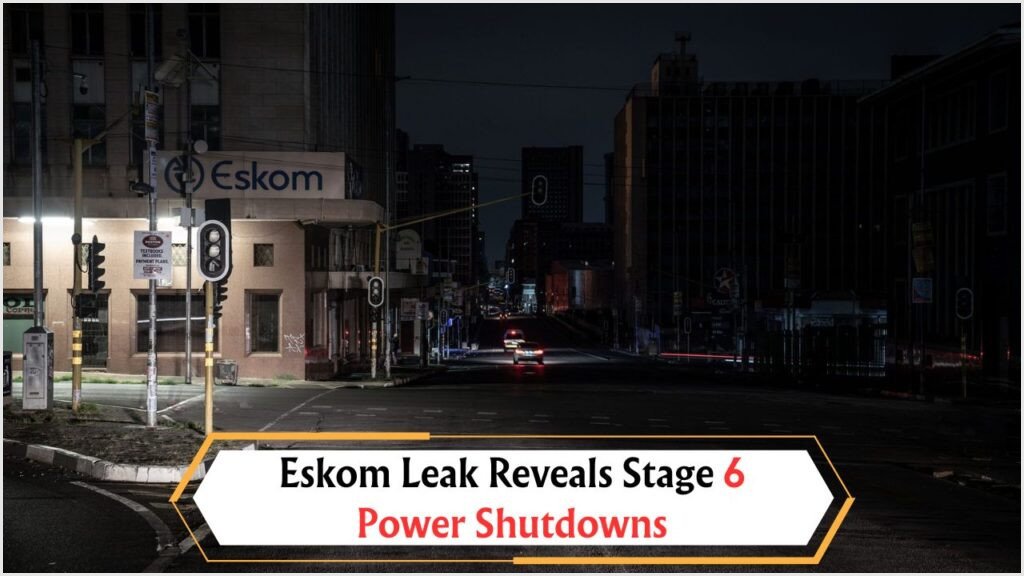Eskom’s August 2025 Strategy: South Africans are understandably concerned as they ponder the implications of Eskom’s August 2025 strategy, which includes the possibility of Stage 6 load shedding. This energy crisis has become a recurring nightmare, affecting both industrial productivity and everyday life. With Eskom’s plans for August 2025, the possibility of increased load shedding levels raises questions about the stability of the national grid and the measures being put in place to prevent such an outcome. As the nation navigates through these challenges, understanding Eskom’s strategy is vital for households and businesses alike.
Understanding Eskom’s August 2025 Strategy for Load Shedding
The August 2025 strategy outlined by Eskom aims to address the persistent energy shortfalls that have plagued South Africa for years. The primary focus is on improving infrastructure, enhancing maintenance schedules, and exploring alternative energy sources to mitigate the risk of Stage 6 load shedding. Historically, load shedding has been a consequence of inadequate power generation capacity, system failures, and insufficient maintenance. Eskom’s strategy includes:
 Discover the Fastest Way to Unlock NSFAS Funds: Thousands Swear by This Proven Appeal Format!
Discover the Fastest Way to Unlock NSFAS Funds: Thousands Swear by This Proven Appeal Format!
- Investing in renewable energy projects to diversify energy sources.
- Upgrading existing power plants to improve efficiency.
- Implementing advanced technology for real-time monitoring and management of the power grid.
- Collaborating with international experts to incorporate global best practices.
- Engaging with the public to promote energy-saving practices.
Is Stage 6 Load Shedding a Likely Reality in 2025?
The specter of Stage 6 load shedding has loomed over South Africans since the concept was first introduced. This level of power outage would mean more frequent and prolonged blackouts, severely impacting daily life and economic activities. While Eskom’s strategy aims to avert such a crisis, several factors could still lead to its implementation:
- Delays in infrastructure development due to funding constraints.
- Unforeseen technical challenges in upgrading power plants.
- Natural disasters impacting energy production and distribution.
- Continued increases in energy demand without corresponding supply enhancements.
- Political and regulatory hurdles affecting energy policy implementation.
Comparing Eskom’s 2025 Strategy with Past Initiatives
To understand the potential success of Eskom’s August 2025 strategy, it’s essential to compare it with past initiatives. Previous approaches often fell short due to various reasons, including financial constraints and implementation delays. Here’s a comparison of key elements:
 August 17, 2025: R1,250 Foster Child Grant Payout Begins – Ensure You Receive Your SMS Alert!
August 17, 2025: R1,250 Foster Child Grant Payout Begins – Ensure You Receive Your SMS Alert!
| Year | Strategy | Outcome | Challenges | Lessons |
|---|---|---|---|---|
| 2010 | Expansion of coal power plants | Limited success | Environmental concerns | Need for sustainable energy |
| 2015 | Implementation of renewable energy projects | Mixed results | Funding issues | Importance of public-private partnerships |
| 2020 | Focus on maintenance and infrastructure | Improved reliability | Technical limitations | Need for advanced technology |
Public and Private Sector Responses to Eskom’s Strategy
Both the public and private sectors have critical roles to play in supporting Eskom’s strategy to prevent Stage 6 load shedding. The private sector, in particular, can contribute by investing in independent power production and developing innovative energy solutions. Meanwhile, the public sector must ensure regulatory frameworks are conducive to such collaborations. Key responses and initiatives include:
- Public Sector Initiatives: Streamlining regulations to fast-track energy projects and providing incentives for renewable energy installation.
- Private Sector Contributions: Investing in solar and wind energy projects and offering expertise in energy-efficient technologies.
- Community Engagement: Raising awareness about energy conservation and encouraging community-led energy initiatives.
- International Partnerships: Leveraging global expertise and technology to enhance local energy solutions.
- Policy Reforms: Ensuring policies are aligned with sustainable energy goals and addressing systemic challenges.
Case Studies of Successful Energy Management
Several countries have successfully managed similar energy crises, providing valuable lessons for South Africa. By examining these case studies, Eskom can identify effective strategies to apply locally. Noteworthy examples include:
- Germany’s shift to renewable energy through the Energiewende policy.
- China’s large-scale investment in solar power to reduce coal dependency.
- Denmark’s wind energy integration into the national grid.
- Australia’s battery storage solutions for peak demand periods.
- Japan’s energy efficiency campaigns following the Fukushima disaster.
Technological Innovations in Energy Management
Adopting cutting-edge technology is crucial for Eskom to enhance energy management and avert Stage 6 load shedding. Recent innovations in the energy sector offer promising solutions that can be adapted to South African conditions:
| Technology | Application | Benefits | Challenges |
|---|---|---|---|
| Smart Grids | Real-time monitoring | Improved efficiency | High initial costs |
| Energy Storage | Battery solutions | Reliable backup | Limited capacity |
| Renewables Integration | Solar and wind | Sustainable supply | Weather dependence |
| AI Systems | Predictive analysis | Proactive maintenance | Data management complexities |
| Blockchain | Decentralized management | Enhanced transparency | Regulatory concerns |
Impact of Load Shedding on South African Society
Beyond the immediate inconvenience, load shedding has far-reaching impacts on South African society. It affects everything from economic productivity to social dynamics, necessitating a comprehensive approach to energy management. Key impacts include:
- Disruption of small and medium enterprises leading to financial losses.
- Challenges in educational settings due to power outages.
- Impact on healthcare services and emergency response capabilities.
- Increased reliance on generators, leading to higher operational costs.
Future Prospects: A South Africa Beyond Load Shedding
While Eskom’s August 2025 strategy faces significant challenges, it also presents opportunities to reshape the energy landscape. With concerted efforts from all stakeholders, a future beyond load shedding is possible. Essential steps include:
- Continued investment in renewable energy and technological innovation.
- Strengthening public-private partnerships for energy solutions.
- Encouraging community participation in energy conservation efforts.
- Developing resilience strategies to adapt to changing energy demands.
The journey towards stable energy supply is complex, but with determination and collaboration, South Africa can overcome the looming threat of Stage 6 load shedding and pave the way for a brighter, more sustainable future.
FAQs on Eskom’s Load Shedding Strategy
What is Stage 6 load shedding?
Stage 6 load shedding involves shedding up to 6,000 MW of electricity, leading to more frequent power outages.
How does Eskom plan to prevent Stage 6 load shedding?
Eskom plans to prevent Stage 6 by investing in renewable energy, upgrading infrastructure, and fostering international collaborations.
What can individuals do to help mitigate load shedding?
Individuals can help by conserving energy, using energy-efficient appliances, and participating in community energy initiatives.
How does load shedding affect South African businesses?
Load shedding disrupts business operations, leading to financial losses and increased operational costs due to generator reliance.
Are there any successful international examples Eskom can learn from?
Yes, countries like Germany and Denmark have successfully integrated renewable energy, offering valuable lessons for Eskom.




